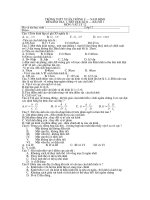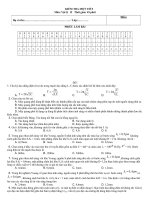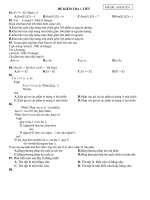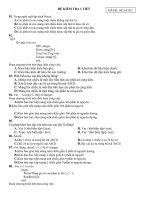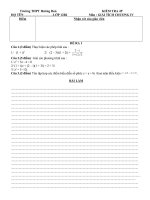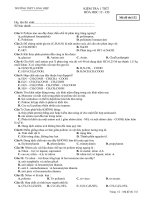Kiem tra 1 tiet 12 Unit 123
Bạn đang xem bản rút gọn của tài liệu. Xem và tải ngay bản đầy đủ của tài liệu tại đây (109.49 KB, 3 trang )
<span class='text_page_counter'>(1)</span><div class='page_container' data-page=1>
SỞ GD & ĐT ĐỒNG THÁP
TRƯỜNG THPT CHU VĂN AN
<b>ĐỀ KIỂM TRA 1 TIẾT LẦN I/HKI</b>
<b>MÔN TIẾNG ANH 12 (CTC)</b>
<i>Thời gian làm bài: 45phút; </i>
<i>(40 câu trắc nghiệm)</i>
<b>Mã đề 001</b>
Họ, tên học sinh:...Lớp:...
<b>Câu 1: Identify the one underlined part A, B, C or D that must be changed for the sentence to be correct:</b>
They asked me how long did it take to get to Paris by train.
<b> A B C D</b>
<i><b>Read the text carefully, choose the optiopns that best complete or answer the questions from 2 to 6:</b></i>
Today, in many parts of the world, it is customary for people to shake hands upon meeting as gesture
of good will. Originally, however, the practice of shaking hands had a more practical purpose.
Shaking hands originated in medieval times. In those days, when a man came on a stranger, he would
often automatically reach for his sword with his right hand, in case he had to use the weapon to defend
himself. Sometimes, both parties found themselves circling around each other, weapons in hand, until it was
mutually agreed that the weapon could be laid aside. Then, the two parties extended their right hands to show
they had no weapons, and clasped them. This was the beginning of the handshake.
The custom of shaking hands is not a universal one. In the Orient, people have, fir centuries, clasped
their own hands in front of them upon meeting to show that they held no weapons. In France, a custom
developed in which people who met would kiss each other on both cheeks. The natives of some South Seas
islands greet by rubbing noses.
<b>Câu 2: At first, the purpose of shaking hands was ______ .</b>
<b>A. to show a good friendship with each other</b> <b>B. to show that there were no weapons in hands</b>
<b>C. to show that both parties were ready for a fight</b> <b>D. a gesture of good will</b>
<b>Câu 3: To show that one has no intention to fight,______ .</b>
<b>A. shaking hands has been practiced on over the world</b>
<b>B. the oriental people kiss each other’s hand</b>
<b>C. people laid aside their weapons</b>
<b>D. there have been various ways depending on different cultures</b>
<b>Câu 4: According to the passage, the practice of shaking hands ______ .</b>
<b>A. was used to extend greetings</b> <b>B. used to be popular, but now it is out of date</b>
<b>C. is considered not to be very polite</b> <b>D. is replaced by other customs in some countries</b>
<b>Câu 5: The word “came on” in the second paragraph can best be replaced by ______ .</b>
<b>A. waited for</b> <b>B. visited</b> <b>C. attacked</b> <b>D. happened</b>
<b>Câu 6: Which of the following is not true about the handshake?</b>
<b>A. It happened for the first time very long times ago.</b>
<b>B. It is a gesture of good will.</b>
<b>C. It is very popular all over the world</b>
<b>D. It is one of the social customs.</b>
<b>Câu 7: Choose the best answer A, B, C or D to complete the following sentence:</b>
After he ______ English course, he went to England to continue his study.
<b>A. had finished</b> <b>B. would finish</b> <b>C. was finished</b> <b>D. has finished</b>
<b>Câu 8: Choose the best answer A, B, C or D to complete the following sentence:</b>
I come ______ a family of five people: my parents, my two younger brothers and I.
<b>A. on</b> <b>B. of</b> <b>C. from</b> <b>D. with</b>
<b>Câu 9: Choose the best answer A, B, C or D to complete the following sentence:</b>
Now you _______ from New York to Los Angeles in a matter of hours.
<b>A. can fly</b> <b>B. will fly</b> <b>C. would fly</b> <b>D. are flying</b>
<b>Câu 10: Choose the best answer A, B, C or D to complete the following sentence:</b>
</div>
<span class='text_page_counter'>(2)</span><div class='page_container' data-page=2>
______ at someone is usually considered rude.
<b>A. To point</b> <b>B. Point</b> <b>C. Pointed</b> <b>D. Pointing</b>
<b>Câu 11: Choose the sentence A, B, C or D that has the same meaning to the provided sentence.</b>
Cindy said that “I haven’t seen John since last month.”
<b>A. Cindy said she hasn’t seen John since the previous month</b>
<b>B. Cindy said she hadn’t seen John since the previous month</b>
<b>C. Cindy said she wasn’t seen John since last month</b>
<b>D. Cindy said she doesn’t see John since previous month</b>
<b>Câu 12: Choose the word whose underlined part is pronounced differently from the rest of the group.</b>
<b>A. school</b> <b>B. children</b> <b>C. teacher</b> <b>D. chore</b>
<b>Câu 13: Choose the best answer A, B, C or D to complete the following sentence:</b>
Gestures such as waving and handshaking are ______ forms of communication.
<b>A. direct</b> <b>B. regular</b> <b>C. verbal</b> <b>D. non-verbal</b>
<b>Câu 14: Choose the best answer A, B, C or D to complete the following sentence:</b>
My father has an older sister he hasn’t seen ______ thirty years.
<b>A. since</b> <b>B. during</b> <b>C. in</b> <b>D. for</b>
<b>Câu 15: Choose the best answer A, B, C or D to complete the following sentence:</b>
It is generally believed that "Men build _______ house and women make it _______ home".
<b>A. Ø / Ø</b> <b>B. a / an</b> <b>C. the / Ø</b> <b>D. an / the</b>
<b>Câu 16: Identify the one underlined part A, B, C or D that must be changed for the sentence to be correct:</b>
The teacher told Joe stopped interrupting his explaining the new lecture.
A <b> B C</b> <b> D</b>
<b>Câu 17: Choose the best answer A, B, C or D to complete the following sentence:</b>
Unlike most men, my father enjoys ______ .
<b>A. cook</b> <b>B. cooks</b> <b>C. cooking</b> <b>D. to cook</b>
<b>Câu 18: Choose the best answer A, B, C or D to complete the following sentence:</b>
While studying, he was financially dependent ______ his parents.
<b>A. to</b> <b>B. from</b> <b>C. on</b> <b>D. of</b>
<b>Câu 19: Choose the best answer A, B, C or D having the nearest meaning with the underlined part:</b>
Our parents join hands to give us a nice house and a happy home.
<b>A. work together</b> <b>B. manage</b> <b>C. help together</b> <b>D. deal with</b>
<b>Câu 20: Identify the one underlined part A, B, C or D that must be changed for the sentence to be correct:</b>
Last night while we watched an exciting game on television in our living room, the electricity went out.
<b> A B C D</b>
<b>Câu 21: Choose the best answer A, B, C or D to complete the following sentence:</b>
- You look great in this new dress. - ________.
<b>A. I am glad you like it</b> <b>B. Not at all</b>
<b>C. With pleasure</b> <b>D. Do not say anything about it</b>
<b>Câu 22: Choose the word whose stress pattern is different from the others of the group.</b>
<b>A. diversity</b> <b>B. generation</b> <b>C. independent</b> <b>D. similarity</b>
<b>Câu 23: Choose the sentence A, B, C or D that has the same meaning to the provided sentence.</b>
“Don’t talk in class”, the teacher said.
<b>A. The teacher told his student not talking in class.</b>
<b>B. The teacher told his student not to talk in class.</b>
<b>C. The teacher told his student did not talk in class.</b>
<b>D. The teacher told his student do not talk in class.</b>
<b>Câu 24: Choose the word whose underlined part is pronounced differently from the rest of the group.</b>
<b>A. demanded</b> <b>B. invited</b> <b>C. washed</b> <b>D. rented</b>
<b>Câu 25: Choose the sentence A, B, C or D that has the same meaning to the provided sentence.</b>
Peter asked me ______ .
<b>A. what time the film started</b> <b>B. what time did the film start</b>
<b>C. what time does the film start</b> <b>D. what time the film starts</b>
</div>
<span class='text_page_counter'>(3)</span><div class='page_container' data-page=3>
<b>Câu 26: Choose the word whose stress pattern is different from the others of the group.</b>
<b>A. secure</b> <b>B. support</b> <b>C. believe</b> <b>D. project</b>
<b>Câu 27: Identify the one underlined part A, B, C or D that must be changed for the sentence to be correct:</b>
The father told to his son not to waste his time playing games all day.
A B C D
<b>Câu 28: Identify the one underlined part A, B, C or D that must be changed for the sentence to be correct:</b>
He said that he couldn't remember where he left his car two days before.
<b> A</b> <b> B</b> <b> C D</b>
<b>Câu 29: Choose the best answer A, B, C or D to complete the following sentence:</b>
My mother is a very ______ woman. She takes the responsibilities for running the household.
<b>A. caring</b> <b>B. care</b> <b>C. careless</b> <b>D. careful</b>
<i><b>Choose the correct option (A, B, C or D) to fill in each of the blanks from question 30 to 34:</b></i>
<b>OTHER CULTURES</b>
What is culture? Culture (30)____ the way of living of a particular group of people. People from different
cultures grow up with different customs, beliefs and values. For example, if you travel from one country (31)
___ another, you probably find the people do something very (32) ___ to the ways you are familiar with in
your culture. Culture is usually run from parents to children for many (33) ___, so people sometimes believe
that their culture is the only correct way to live.
Do you think everyone in the world should do things as you do them in your culture or (34) ___ you
open-minded about other customs? Many people believe that learning about other cultures can be educational and
rewarding.
<b>Câu 30: A. mean</b> <b>B. meaning</b> <b>C. means</b> <b>D. to mean</b>
<b>Câu 31: A. for</b> <b>B. to</b> <b>C. about</b> <b>D. off</b>
<b>Câu 32: A. indifferent</b> <b>B. differently</b> <b>C. different</b> <b>D. difference</b>
<b>Câu 33: A. couples</b> <b>B. families</b> <b>C. generations</b> <b>D. partners</b>
<b>Câu 34: A. have</b> <b>B. do</b> <b>C. will</b> <b>D. are</b>
<b>Câu 35: Choose the best answer A, B, C or D to complete the following sentence:</b>
We always feel ______ and secure in our family.
<b>A. safeness</b> <b>B. safe</b> <b>C. safely</b> <b>D. safety</b>
<b>Câu 36: Choose the word whose underlined part is pronounced differently from the rest of the group.</b>
<b>A. shifts</b> <b>B. hands</b> <b>C. groups</b> <b>D. works</b>
<b>Câu 37: Choose the best answer A, B, C or D to complete the following sentence:</b>
How ______ since we ______ college?
<b>A. have you been / left</b> <b>B. have you been / have left</b>
<b>C. are you / left</b> <b>D. were you / left</b>
<b>Câu 38: Choose the sentence A, B, C or D that has the same meaning to the provided sentence.</b>
“Please don’t leave until I come back”, Sarah said.
<b>A. Sarah told us do not leave until she comes back. B. Sarah asked us not leave until she came back.</b>
<b>C. Sarah told us not to leave until she came back. D. Sarah said to us not to leave until she comes back.</b>
<b>Câu 39: Choose the sentence A, B, C or D that has the same meaning to the provided sentence.</b>
“Have you heard of her marriage?”
<b>A. She asked me if I hear of their marriage</b> B. She asked me whether I had heard of their marriage
<b>C. She asked me if I had heard of their marriage D. B and C</b>
<b>Câu 40: Choose the best answer A, B, C or D to complete the following sentence:</b>
- What an attractive hair style you have got, Mary! - _______
<b>A. Thank you for your compliment</b> <b>B. I don't like your sayings</b>
<b>C. You are telling a lie</b> <b>D. Thank you very much. I am afraid</b>
<b>---***** E N D ---*****</b>
</div>
<!--links-->
